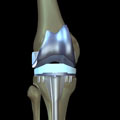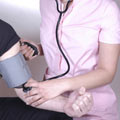Description of the test
Blood pressure monitoring measures your blood pressure. Blood pressure is a measure of the force of the blood against the walls of the arteries, and it is monitored regularly by your doctor to ensure that it remains within a healthy range. High blood pressure, or hypertension, can lead to many complications including stroke, kidney failure, and heart disease.
How often should the test be performed?
The frequency of blood pressure testing will be determined by your health care provider. If your blood pressure is high, your doctor may ask you return to the office more frequently either to determine if treatment (including medication) is required to reduce your blood pressure or to monitor the effectiveness of treatment already in place.
Why is this test performed?
Blood pressure can go up and down during the course of a day; however, if blood pressure remains consistently high, it is called hypertension. Most people have no symptoms of high blood pressure, so regular blood pressure monitoring is needed to identify people with hypertension.
Long-term hypertension can cause complications such as stroke, heart attack, and kidney failure. Once high blood pressure is detected, many steps can be taken to control blood pressure and prevent such complications from occurring. This includes exercise, a change in diet, and medications. Regular blood pressure monitoring will assess the effectiveness of treatments so they can be adjusted as needed.
Are there any risks and precautions?
The blood pressure cuff may feel tight around your arm and may be temporarily uncomfortable, but there are no risks of complications or side effects with monitoring blood pressure.
What happens during the test?
The doctor uses a device called a sphygmomanometer (a pressure gauge attached to a blood pressure cuff) to measure your blood pressure. The blood pressure cuff is placed around your upper arm just above the elbow and a stethoscope is held over your brachial artery (the blood vessel just on the inside of your elbow joint). The cuff is inflated to temporarily block blood from flowing through the artery.
As the air is slowly let out of the cuff, your doctor waits to hear the onset of a whooshing noise and when it stops. The onset of the noise indicates that the pressure in your arteries is equal to the pressure in the cuff, allowing blood to flow again. This pressure is the systolic blood pressure, and this will be indicated on the gauge as the first number of your blood pressure reading (e.g., 120 if your blood pressure reading is "120 over 80"). Systolic pressure roughly indicates how strong the heart pushes blood through the arteries. You can think of systolic pressure as the pressure that occurs in the arteries when your heart contracts.
When the whooshing noise disappears, this is the diastolic blood pressure, which roughly indicates the residual pressure in the arteries. You can think of diastolic pressure as the pressure that occurs in the arteries when your heart relaxes.
Blood pressure is read with the systolic blood pressure over the diastolic blood pressure. For example, a blood pressure of "120/80 mmHg" (measured in millimetres of mercury) is referred to as "120 over 80."
Your doctor may also use an electronic or digital device to measure your blood pressure. These devices need to be compared to the technique above to make sure they are working correctly.
How should I prepare for this test?
Wear a short-sleeved shirt when you have your blood pressure monitored, and avoid things that cause your body to be excited such as drinking beverages with caffeine or smoking an hour before the test. You should also sit down with your back supported and feet flat on the floor for at least 5 minutes before the test. You should also go to the bathroom before the test. Most importantly, relax.
Tell your doctor or prescriber about all prescription, over-the-counter (non-prescription), and herbal medications that you are taking. Also tell them about any medication allergies and medical conditions that you may have.
Ask your doctor or pharmacist whether you need to stop taking any of your medications before the test.
What can I expect after the test?
You can return to your normal activities immediately after the test. However, call your doctor if you begin to experience worsening heart-related symptoms following the test.
Results
Ask your doctor for your blood pressure reading as well as help in understanding what it means.
Blood pressure is usually considered high when it is consistently greater than 140/90 mmHg. If you are being treated for high blood pressure, your blood pressure should be below this target. However, some people with kidney disease or diabetes need to aim for even lower blood pressure targets of 130/80 mmHg. You should discuss with your doctor what target is right for you.
People who have high-normal blood pressure (systolic blood pressure between 130 mmHg and 139 mmHg and diastolic blood pressure between 85 mmHg and 89 mmHg, without diabetes) may develop hypertension. Your doctor may suggest follow-up and recommend you start diet changes and exercise. Medications may not need to be started at this time unless you have other medical conditions.
If you are concerned about your blood pressure, you can also monitor your blood pressure at home. Ask your doctor if monitoring your blood pressure at home is right for you.
All material copyright MediResource Inc. 1996 – 2024. Terms and conditions of use. The contents herein are for informational purposes only. Always seek the advice of your physician or other qualified health provider with any questions you may have regarding a medical condition. Source: www.medbroadcast.com/procedure/getprocedure/Blood-Pressure-Monitoring


